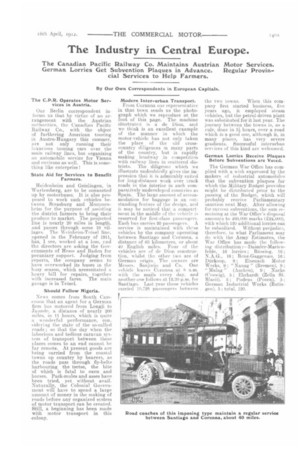The Industry in Central Europe.
Page 17

If you've noticed an error in this article please click here to report it so we can fix it.
By Our Own Correspondents in European Capitals.
The C.P.R. Operates Motor Services in Austria.
Our Berlin correspondent informs us that by virtue of an arrangement with the Austrian authorities, the Canadian Pacific Railway Co., with the object of furthering American touring in Austro-Hungary this summer, are not only running their luxurious touring cars over the main railway lines, but organizing an automobile service for Vienna and environs as well. This is something like enterprise!
State Aid for Services to Benefit Farmers.
Heidenheim and Geislingen, in Wurternberg, are to be connected up by motorbuses. It is also proposed to work such vehicles between Strasburg and Mommenbeim for the purpose of assisting the district farmers to bring, their produce to market. The projected line is nearly 20 miles in length, and passes through some 10 villages. The Weinheim-Triisel line, opened in the February of 1911., has, I see, worked at a loss, end the directors are asking the Governments of Hesse and Baden for pecuniary support. Judging from reports, the company seems to have overworked its buses in the busy season, which necessitated a heavy bill for repairs, together with increased fares. The main garage is in Triisel.
Should Follow Nigeria.
News comes front South Cameroon that an agent for a German firm has motored from Longji to Jaunde, a distance of nearly 200 miles, in 11 hours, which is quite
wonderful performance, considering the state of the so-called roads ; so that the day when the laborious and tedious caravan system of transport between these places comes to an end cannot be far remote. At present goods are being carried from the coastal towns up country by bearers, as the roads pass through fly-belts harbouring the tsetse, the bite of which is fatal to oxen and horses. Pack-mules and asses have been tried, yet without avail. Naturally, the Colonial Government will have to spend a .large amount of money in the making of roads before any organized system of motor transport can be created. Still, a beginning has been made with motor transport in tins -colony. Modern Inter-urban Transport.
From Corunna our representative in that town sends us the photograph which we reproduce at the foot of this page. The machine illustrated is a de Dion, and we think is an excellent example of the manner in which the motor-vehicle has not only taken the place of the old crosscountry diligences in many parts of the country, but is rapidly making headway in competition with railway lines in scattered districts. The diligence which we illustrate undoubtedly gives the impression that it is admirably suited for long-distance work over truck roads in the interior in such comparatively undeveloped countries as Spain. The large amount of accommodation for baggage is an outstanding feature of the design, and it may be noticed that a compartment in the middle of the vehicle is reserved for first-elass passengers. Each bus carries 20 passeagers. A service is maintained with these vehicles by the company operating between Santiago and Corunna. a distance of 63 kilometres, or about 40 English miles. Four of the vehicles are of de Dion construction, whilst the other two are of German origin. The owners are Messrs. Sanjurjo and Co. One vehicle leaves Corunua at S a.m. with the mails every day, and another one follows at 12.30 p.m. for Santiago. Last year these vehicles carried 10,728 passengers between
the two towns. When this company first started business, five years ago, it employed steam vehicles, but the petrol-driven plant was substituted for it last year. The journey between the towns is, as a rule, done in 3 hours over a road which is a good one, although it, in many places, has very severe gradients. Successful interurban services of this kind are welcomed.
German Lorries Receive Plaques Before Subventions are Voted.
The German War Office has complied with a wish expressed by the makers of industrial automobiles that the subvention plaques for which the Military Budget provides might be distributed prior to the passing of the Budget, which will probably receive Parliamentary sanction next May. After allowing for current subventions, the sum remaining at the War Office's disposal amounts to 480,000 marks (S:24,000), with which 120 additional lorries can be subsidized. Without prejudico, therefore, to what Parliament may do with the Army Estimates, the War Office has made the followiug distribution :—Daimler-Marienfelde, 16 lorries ; Bussing, 16 ; N.A.G., 161 Benz-Gaggenau, 16; Darkoop„ 9; Eisenach Motor Works, 9 ; "Nanag " (Bremen), 9 ; " Mulag " (Aachen), 9 ; Nacke (Coswig), 5; Ehrhardt (Zella St. Blasii), 5 ; Podeus (Posen),.
German German Industrial Works. (Ratingen), 5 total, 120.






















